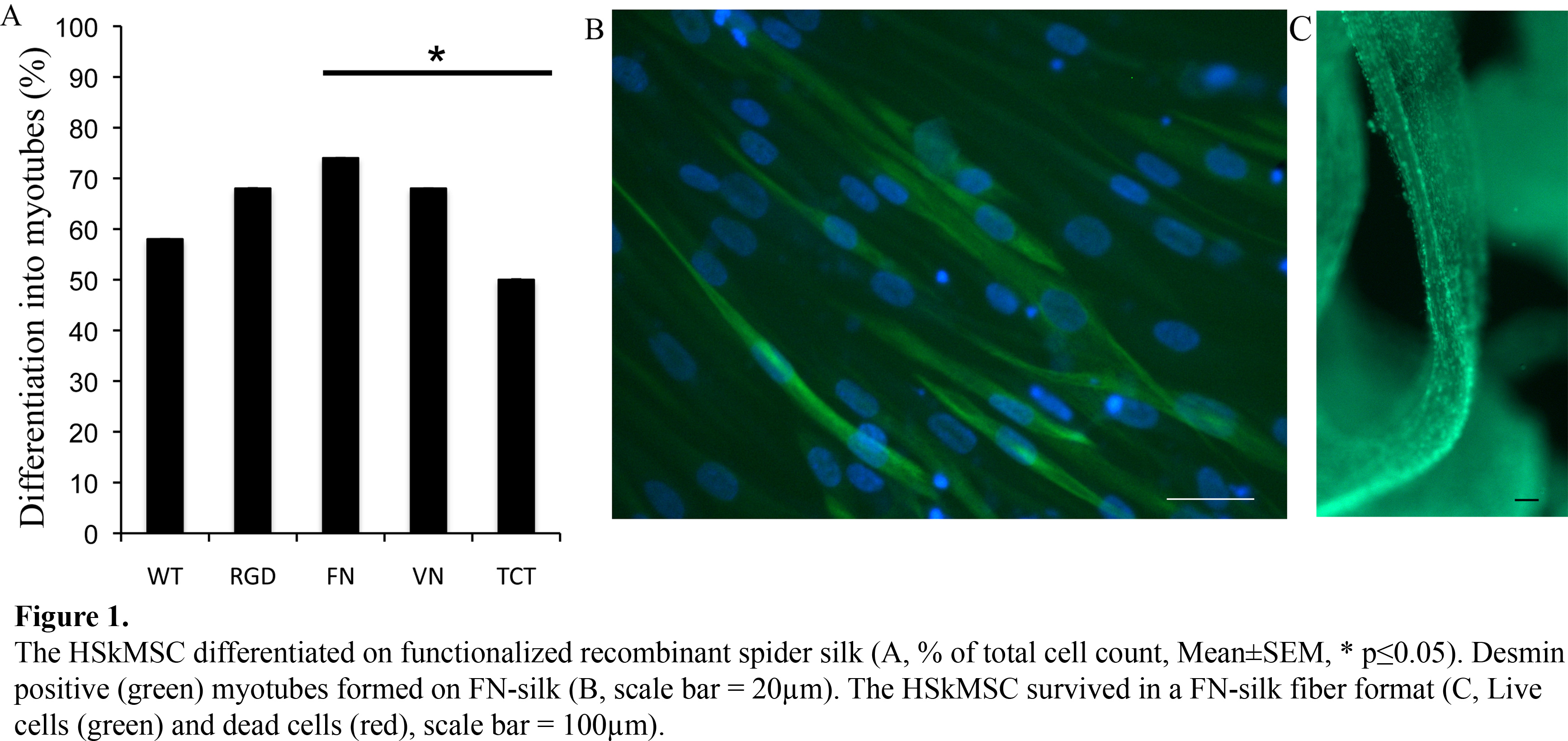Introduction: Satellite cells are myogenic precursors that reside as a quiescent cells in every muscle fiber. Upon minor muscle injury the satellite cells are able to proliferate and give rise to a regenerated muscle and new satellite cells. Severe injury with extensive loss of skeletal muscle results in unrepaired muscle tissue and malfunction. The regeneration of myogenic tissue needs, besides precursor cells, a direction by specific extracellular matrix (ECM)[1]. The ECM directs the muscle regeneration into fibers with a unique alignment to connect with the surrounding tissue for restoration of function[2]. We have developed methods to functionalize recombinant spider silk proteins with peptides from the ECM[3],[4]. The properties of the functionalized spider silk may offer a scaffold with appropriate strength, elasticity, fiber guidance and adequate porosity. Herein we investigate if functionalized recombinant spider silk can act as support for muscle regeneration.
Materials and Methods: Human skeletal muscle satellite cells (HSkMSC) were seeded and cultured on a coated layer of recombinant spider silk with functionalized ECM motifs from fibronectin (FN), vitronectin (VN) and RGD. As controls we used non-functionalized recombinant spider silk (WT), hydrophobic plates (HP) as well as tissue culture treated (TCT) plates without recombinant spider silk coating. The quick adhesion of HSkMSC on the different ECM coated wells were studied using crystal violet. The proliferation capacities were followed over 7 days using Alamar Blue. In parallel, HSkMSC were cultured until cell density reached a confluency of 90% and thereafter a myogenic differentiation protocol was initiated using DMEM with low glucose and 2% FBS. After 7 days of differentiation the cells were fixed in 4% PFA and stained for the myogenic marker Desmin. Furthermore, HSkMSC were seeded and cultured on FN-silk in fiber format. The cell growth was followed over a 2 weeks’ time period, using Alamar Blue. The cell viability at the endpoint was analyzed as well.
Results and Discussion: The HSkMSC were able to adhere to all silk variants of ECM motifs. The most pronounced adherent effect was seen on the FN-silk where HSkMSC were able to proliferate to the same degree as in the TCT-control. Moreover, FN-silk increased the myogenic capacity of HSkMSC (74 %) compared to TCT-control (50%, Fig. 1A). The HSkMSC formed myotubes on all silk variants with ECM motifs; on FN-silk multi nucleated myotubes were formed (Fig. 1B).
The HSkMSC aligned, survived and proliferated also in the flexible and permeable 3D fiber format of FN-silk (Fig.1C).
Conclusion: We propose that the use of spider silk matrices with ECM motifs could be useful for development of a therapeutic option for muscle engineering due to its ability to adhere and align satellite cells along an elastic, permeable scaffold which support differentiation.

Spiber Technologies AB is acknowledged for providing recombinant spider silk proteins. The Swedish Research Council, FORMAS and Knut and Alice Wallenberg Foundation supported this work.
References:
[1] Fibronectin promotes migration, alignment and fusion in an in vitro myoblast cell model. Vaz R. et al. Cell Tissue Res. 2012 Jun;348(3):569-78.
[2] A transitional extracellular matrix instructs cell behavior during muscle regeneration. Calve S. et al. Dev Biol. 2010 Aug 1;344(1):259-71.
[3] Recombinant spider silk as matrices for cell culture. Widhe M. et al. Biomaterials. 2010 Dec;31(36):9575-85
[4] Recombinant spider silk with cell binding motifs for specific adherence of cells. Widhe M et al. Biomaterials. 2013 Nov;34(33):8223-34